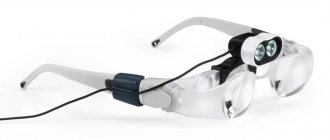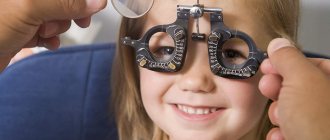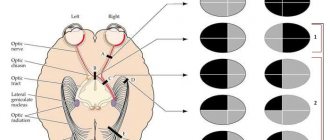Blindness and low vision
Absolute or medical blindness is a complete loss of vision, the inability to distinguish light from dark. In this condition, vision is 0. There is also a distinction between civil (or practical, everyday) blindness, in which the ability to navigate the environment and move outside the house without assistance is lost, but the perception of light and even the ability to distinguish the contours of large objects are preserved. The category of practically blind includes persons with visual acuity from light perception to 0.04 in the better eye with tolerable correction by conventional means. This type of vision is called residual vision. It should be kept in mind that the criteria for determining civil blindness vary from country to country. Residual vision contributes to the development of some spatial concepts, but it is not sufficient to use it to perform work that requires constant visual control. Therefore, education and training of practically blind people, as well as persons with absolute blindness, are carried out without the participation of their visual system.
People whose visual acuity in the better eye with conventional optical correction is 0.05–0.2 are called visually impaired. This allows such persons, under particularly favorable conditions, to use their vision for learning and performing other work that does not require high visual acuity. Telescopic glasses, magnifying glasses and other special vision correction devices significantly facilitate the visual work of the visually impaired and increase their performance.
For them, universal 9-year education has been introduced, and a network of special schools has been developed. An ophthalmologist serving a school for blind and visually impaired children plays the main role in implementing a system of measures to protect weak and residual vision in students. An ophthalmologist takes part in staffing schools for blind and visually impaired children, systematically conducts in-depth examination of the visual organs of all students in these schools, provides them with the necessary treatment, strives to create optimal hygienic conditions in schools for blind and visually impaired children, and advises school teachers on all these issues.
When staffing special schools, you should follow the instructions for admitting children to schools for the blind and visually impaired. The vision examination card completed before sending the child to the school for the blind and visually impaired should be carefully checked to ensure that the examination was carried out correctly and sufficiently fully. In the first days of the school year, the ophthalmologist, together with nurses and teachers, must correctly seat students in the classroom in accordance with the state of their vision and height. Twice a year, in-depth examinations of the organ of vision in children should be carried out. The results of the examination, as well as the doctor’s detailed recommendations regarding the regimen of educational classes and visual work, treatment, optical means of vision correction, consultations with other specialists, and physical education classes are entered into the medical record.
Children with progressive diseases of the visual organ (glaucoma, incomplete optic atrophy, traumatic cataracts, retinal pigmentary degeneration, inflammatory diseases of the cornea, complicated myopia, retinal detachment, etc.) and with eye conditions (some forms of congenital and secondary cataracts, etc.) deserve special attention. amblyopia, etc.), in which it is possible to improve vision subject to active, highly qualified treatment.
Blind societies carry out a great deal of work to attract blind people to socially useful work and raise their cultural level. Members of the society are accepted from the age of 14 with visual acuity in the better eye up to 0.08 (with correction), as well as with a sharp narrowing of the field of vision.
The continuously increasing well-being of the population, increasing material and cultural levels, widespread preventive measures and the development of specialized eye care contribute to a further reduction in the number of blind and visually impaired people.
Next to cancer, blindness is considered the most terrible disease. It is a potential condition of severe disability and a threat to a person's quality of life.
According to the international non-governmental organization SVM, there are more than 37 million blind people in the world and more than 124 million with low vision. About 7 million people go blind every year.
According to the Ministry of Health and Social Development of the Russian Federation, about 1 million babies are born with poor vision, and by the age of 15, the number of children with visual impairment triples. Loss of vision and problems associated with its deterioration require significant costs for socio-economic support for this group of people from the state.
In Russia, 500 thousand visually impaired people are registered annually, and every second resident of the country suffers from eye disease. The incidence of eye diseases in Russia is steadily increasing, and in most regions it exceeds the European average by 1.5-2 times. A decrease in vision to 0.05-0.03 makes a person almost completely dependent on the people around him.
The visually impaired include persons with a significant decrease in visual acuity, in whom the visual acuity of the better eye with conventional optical correction is 0.05 - 0.2 diopters. Low vision is considered a visual condition in which no means of correcting ametropia can achieve visual acuity higher than 0.3.
Low vision occurs as a result of developmental abnormalities or eye diseases, which is often a manifestation of a general disease of the body. The causes of low vision are diseases such as: glaucoma, diabetic retinopathy, amblyopia, nystagmus, albinism, microphthalmos, retinal degeneration, macular degeneration. But still, in most cases, low vision is a consequence of refractive errors of the eye. Low vision negatively affects, first of all, the process of visual perception, complicating and slowing it down. With low vision, insufficiently clear, unstable, and sometimes incorrect representations of perceived objects are formed.
A person with low vision has difficulty or does not perform the same work as a person with regular glasses or contacts. He has a lower ability to work, needs social training, labor, household, social and medical rehabilitation.
Life in our society is built on visual tasks (reading, orientation in a populated area, housekeeping, driving, etc.). Through vision, a person perceives more than 80% of all information. Approximately 12% is due to hearing. 3% is the sense of smell and only 2% is the sense of taste and touch.
In optics, the principle of magnification is used to correct low vision vision, i.e. the same object at different distances will have a different image on the retina.
If you reduce the distance to an object by 2 times, you get 2 times the magnification on the retina. Reading distance for low vision in optics 25 cm – add +4.0D. The visual angle is compared to an object that is 25 cm away.
The use of means to improve the quality of the image on the retina, and devices that magnify the retinal image (optical and electronic), used for various needs, can significantly improve the lives of people with low vision. The effectiveness of selecting tools to improve the quality of retinal images depends on a number of objective and subjective factors.
If a person has low vision, assistance in solving visual problems can be provided using various technical means of helping the visually impaired – typhlotechnics. For example: spectacle loupes (positive lens or high-refraction lens system), hyperoculars (for monocular use), binocular spectacle loupes, hand-held magnifiers, telescopic glasses, electronic magnifiers.
Magnifying glasses are widely used for various types of visual inspection work. Magnifier - a magnifying device with a two-thousand-year history continues to be popular. They are successfully combined with glasses - hyperoculars for mono or binocular use, enhancing magnification. With a progressive decrease in vision, a magnifying glass is the first tool that a visually impaired person turns to, often independently.
According to technical characteristics, magnifiers are divided into: hand-held, pocket, folding, support, overhead, ruler magnifiers, fixed on glasses, without illumination and with illumination. All magnifying glasses come in different magnifications and designs.
Hand-held magnifying glasses combine well with vision correction with glasses or contact lenses. Their disadvantage is that they need to be held in the hand at a fixed distance. As a rule, they are used only for short-term visual work, positioned from the object at a distance slightly less than the focal length in order to increase the depth of field and reduce aberrations that occur along the periphery of the lens, but with some loss of magnification.
The distance between the magnifying glass and the eye can be arbitrary, but as the eye moves away from the magnifying glass, the field of view decreases proportionally.
Hand magnifiers are portable, light weight, do not require a special workplace, and are very convenient for short-term use. They are used when examining price tags and receipts in stores, bills, and short entries.
Overhead magnifiers are divided into: line, half-line and hemispherical, single-lens and combined. The magnifying glass has a specific focal length and is placed directly on the text. These magnifying glasses are convenient for long-term visual work, especially for elderly people with a narrowed field of vision, with eccentric fixation of the gaze in the presence of scotomas in the field of view.
Scotoma is a focal loss of visual fields, i.e. space visible to the eye. There are cases when a person does not notice a scotoma, and it is discovered only during examination.
The loss of an area in the very center of the visual field indicates macular degeneration, an age-related degenerative lesion of the macula (macula) of the retina.
Ruler magnifiers or line magnifiers enlarge letters vertically without enlarging them horizontally, which keeps the line length constant. Some of them have introduced a narrow strip to help a visually impaired person maintain a line.
Magnifiers fixed on glasses are used for various types of manual work, viewing details, they can also be used when writing and reading, combined with glasses for near and hyperocular glasses. Such magnifiers can be in two versions: binocular and monocular.
There are also special magnifiers , for example, “magnifiers for handicrafts” with the lens fixed on the user’s chest, and table magnifiers on a stand. Their magnification does not exceed 2.5 - 3 x.
Special-purpose magnifying glasses are also produced for specific jobs. These include magnifying glasses for sewing machines, manicures, etc.
The advantages of using magnifiers if a person has low vision include factors such as the presence of a large range of magnifications, light weight, and the ability to use with other optical magnifiers. About 90% of people with low vision use magnifying glasses.
Unfortunately, when using magnifying glasses, there are also disadvantages. For an elderly person with low vision, reading at close range may have some difficulties.
New sensorimotor coordination of head, eyes, hand and body takes time to master. A person also needs to adapt to a reduced field of vision. He must accurately establish the working distance, optimal lighting using, if necessary, additional light sources.
Currently, the visually impaired have increasingly begun to use technical means of rehabilitation (typhloremedies) - electronic devices. Unlike an optical magnifier, an electronic device has a larger image area and a higher magnification factor. Image clarity is maintained across the entire screen area, making reading especially comfortable.
Electronic devices (electronic magnifiers, digital magnifiers, video magnifiers) are a compact device with a camera and a screen that allows you to view an enlarged image in various modes. This type of typhotechnics is an excellent solution for people with low vision, designed for reading texts with small print (recipes, instructions, information on packages) and examining small details.
The undoubted advantage of digital electronic devices (magnifiers, video enlargers) over conventional optical magnifiers are the following factors:
1. Difference in magnification factors. Electronic devices (magnifiers) allow you to achieve a magnification factor of up to 25x on a 4.3-inch screen. The maximum magnification factor of a regular magnifying glass is 8-10x. This magnification limit is determined by the laws of optical physics.
2. On the screen of an electronic device (magnifying glass), you can easily and simply read the text by seeing whole words, and with a similar magnification magnification, the text can be read only by letter, because Conventional magnifiers have a very small image area. There is a direct relationship: the higher the magnification factor of a regular magnifying glass, the smaller its diameter. For example, at 8x magnification, the diameter of a regular magnifying glass will be about 3 cm, which will allow you to see only one letter.
3. Electronic devices (magnifying glasses) do not produce edge distortions, and when reading through a regular magnifying glass, the edges of the image become unclear and begin to blur.
4. Thanks to the “freeze frame” function, an electronic device (magnifying glass) allows you to capture an image (take a photograph) and then examine it in a calm environment (for example: the composition of a product or expiration date). This is not possible with a regular magnifying glass.
5. Electronic devices also have color mode settings, including: full color, black and white, negative, blue on white, black on yellow, blue on yellow, black on green, allowing people with various visual impairments to perceive information as comfortably as possible.
6. Some models of electronic devices allow you to display images on a TV and computer screen, i.e. If even greater magnification is required, it is possible to view the image on a larger screen. Such manipulations are not possible with ordinary magnifying glasses.
7. Electronic devices also allow step-by-step changes in the magnification factor depending on the size of the parts in question. You can adjust the magnification factor of a regular magnifying glass only by moving it away or bringing it closer to the object in question. This is not very convenient if you hold the magnifying glass suspended and is not technically possible if the magnifying glass is located on a stand.










